by Octavio Jiménez Robles & Gabriel Martínez del Marmol Marín.
In North Africa, three species of large paleartic vipers have been recorded inside the genus Macrovipera sensu Herrmann et al., 1992 (Schleich et al., 2006). Several phylogenetic studies suggest the allocation of two of these species inside the genus Daboia (Lenk et al., 2001; Garrigues et al., 2005; Wüster et al., 2008; Pyron et al., 2011): D. mauritanica (Duméril & Bibron, 1848), and D. deserti (Anderson, 1892). The third described clade in North Africa is Macrovipera lebetina transmediterranea Nilson & Andrén 1988, not included in any recent phylogenetic analysis. The validity of the taxa transmediterranea and deserti as full species is currently uncertain due to the scarcity of records along all their supposed distribution.
After its description in 1988, the existence of M. l. transmediterranea has never been accurately confirmed. It was described from five specimens tagged from Algiers and Tunis (the capitals of Algeria and Tunisia) as a sympatric species with D. mauritanica with shorter body length, reduced number of dorsal scale rows and different colour pattern (Nilson & Andrén, 1988). Another transmediterranea specimen not collected was mentioned to be observed in Djebel Murdjadjo, near Oran, Algeria (Nilson & Andrén, 1988). Bons & Geniez (1996) suggested the possibility that this viper occurs in northeast Morocco, although for the moment there is no information about it. Recently one (or several) snake(s) was(were) identified as M. l. transmediterranea after being captured in rocky areas of north Tunisia, without exact locality (Bazaa et al., 2005; 2006; 2009; Sanz et al., 2006; Liman et al. 2010). In those venom proteomic publications it is not specified whether this specimen was deposited in a scientific collection, so for the moment its identity as the taxon transmediterranea remains unverifiable. In Dobiey & Vogel’s book (page 143, 2007) there is a picture of a viper named as this species, but the specimen has an unknown origin (J.J. Calvete & A. Bazaa, pers. comm.), so it cannot be assigned neither to transmediterranea nor to Tunisia.
Table 1: Some of the main differences between D. mauritanica, D. deserti and M. l. transmediterranea
(based in Anderson, 1892; Kramer & Schnurrenberger, 1963; Nilson & Andrén, 1988; Herrmann et al., 1992).
| mauritanica | deserti | transmediterranea | |
|---|---|---|---|
| colour pattern | wavy undulating zig-zag band along the back which constitutes 23 to 33 blotches or windings (sometimes reddish or brownish with weakly developped pattern) | rather pale with wavy undulating band weakly developed or absent (it fades with age) | 34 to 41 transverse bands (31-46; Herrmann et al., 1992) |
| number of scale rows between the dark blotches and the ventrals (Kramer & Schnurrenberger, 1963) | 5 | 3-4 | ? |
| midbody dorsal scale rows | 27 | 27 | 25 |
| neck scale rows | 26-27 | 26-27 | ~24 |
| scales on upper surface of head | keeled | smooth | keeled |
| canthus rostralis | present | absent | present |
| rostral shield | broader than high | higher than broad | broader than high |
| ventrals | 157-174 ♀♀; 163-170 ♂♂ | 164-170 ♀♀; 166-169 ♂♂ | 150-164 ♀♀; 154-163 ♂♂ |
| subcaudals | 45-48 ♀♀; 45-50 ♂♂ | 44-51 ♀♀; 46-51 ♂♂ | 37-43 ♀♀; 42-51 ♂♂ |
Appart from its scarcity of records, the morphological diagnostic traits of transmediterranea are doubtful. Besides transmediterreanea dorsal colour pattern was described as transversal bars (see Table 1; Nilson & Andrén, 1988), several authors consider it similar to the wavy undulating pattern of mauritanica (Herrmann et al., 1992; Venchi & Sindaco, 2006). Other differences such as the reduced dorsal scales might be inside the variation of juveniles of mauritanica as well (Venchi & Sindaco). Hence, the validity of transmediterranea is questionable (Venchi & Sindaco, 2006; Agasyan et al., 2009; R. Sindaco, pers. comm.). However a specimen of the Natural History Museum of London has recently been identified as M.l. transmediterranea (W. Wuster, pers. comm.).
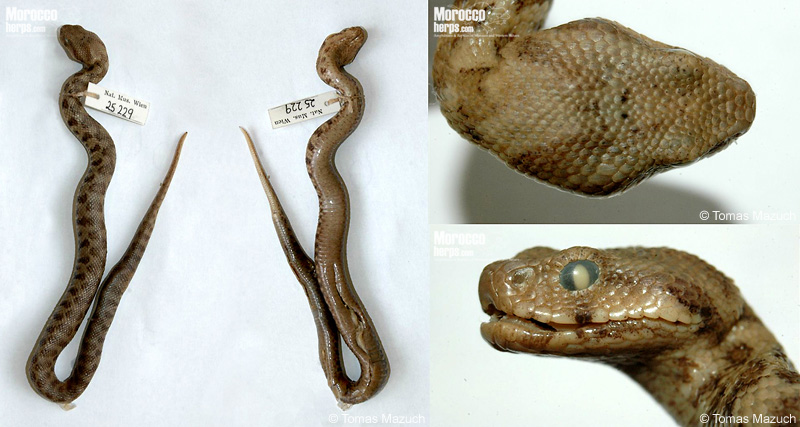
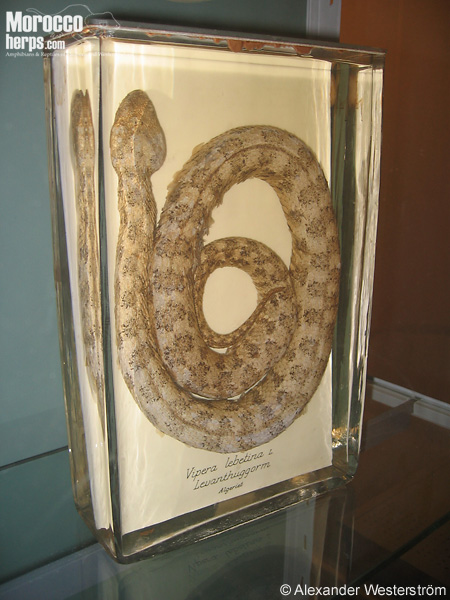
The only concise way of solving this uncertainty on the phylogenetic allocation of the taxon transmediterranea, would be including genetic material of the syntypes in next molecular phylogenetic studies. We suspect the taxon transmediterranea will be probably allocated in the Daboia clade, as it is widely separated from other Macrovipera populations in the Eastern Mediterranean, and close to other Daboia. Evenmore, transmediterranea might be a synonymy of D. mauritanica.
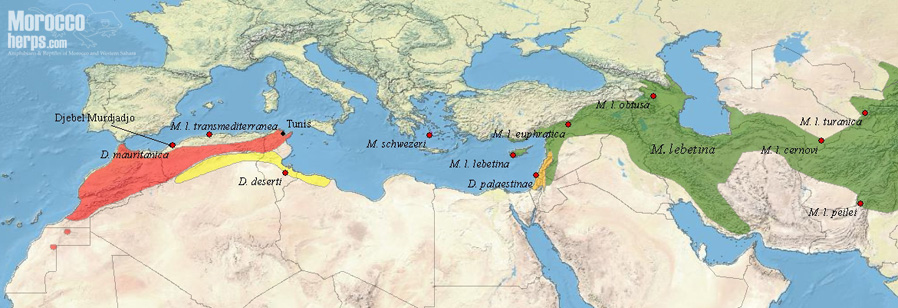
Daboia deserti was described as a subspecies of M. lebetina differing from the type of D. mauritanica by the absence of canthus rostralis and interorbital scales not keeled (Anderson, 1892). As an anecdote, Anderson used for comparison some two of the specimens that later would become syntypes of transmediterranea (Nilson & Andrén, 1988). The colour pattern of deserti was described as “pale yellowish brown above with very faint indications of the dorsal and lateral dark spots distinctive of Algerian and Cyprian examples of the typical form” (Anderson, 1892).
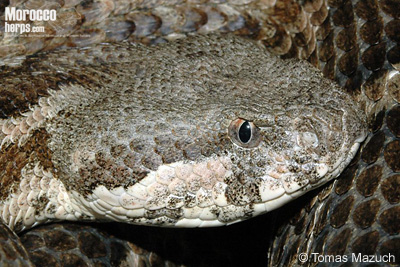
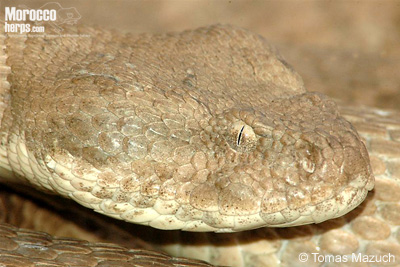
Since the description of deserti its distribution and phylogenetic relations with mauritanica are not clear. Kramer & Schnurrenberger (1963) suggested that deserti should be regarded as a subspecies of D. mauritanica. They stated a disjunct distribution for both taxa: north of the High Atlas Range and coastal areas of Algeria for mauritanica, and from south of the Atlas Range to Libya for deserti. Another morphologic trait was pointed for the diagnosis: the number of scale rows between the dorsal dark blotches and the ventrals is normally more than 5 in mauritanica and 3-4 rows in deserti (Kramer & Schnurrenberger, 1963).
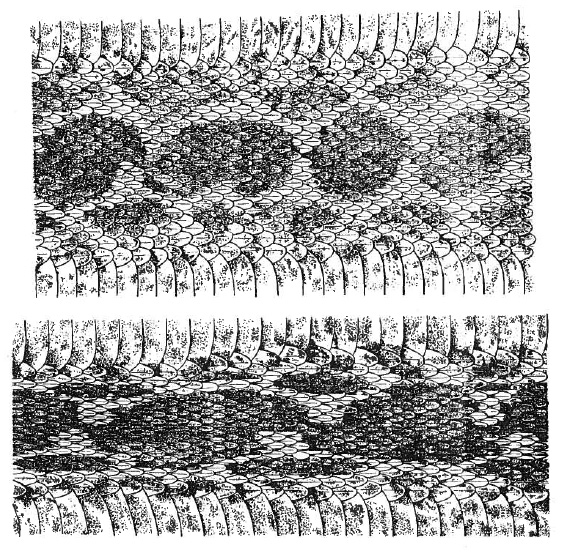
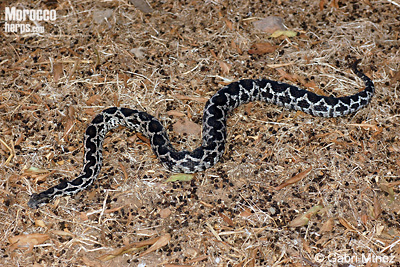
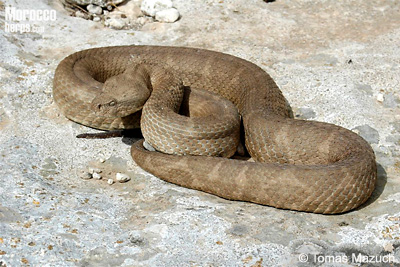
After considering deserti as a close taxon to mauritanica due to morphologic similarities (Kramer & Schnurrenberger, 1963), the work of Herrmann and collaborators (1987; 1992) with non-genetic molecular methods showed differences to separate them again as independent species. The immunological distance of mauritanica to the Cypriotic M. l. lebetina, was smaller than the distance with deserti (Herrmann et al., 1987).
In Morocco some specimens with a pale colour pattern have been found (Destre et al., 1989). They were attributed to a pale morph of D. mauritanica (Saint Girons, 1956; Nilson & Andren, 1988) distributed along the Antiatlas and the south of the High Atlas (Geniez et al., 1991; Bons & Geniez, 1996). However, other authors identified them as D. deserti (Destre et al., 1989; Schleich et al., 1996).
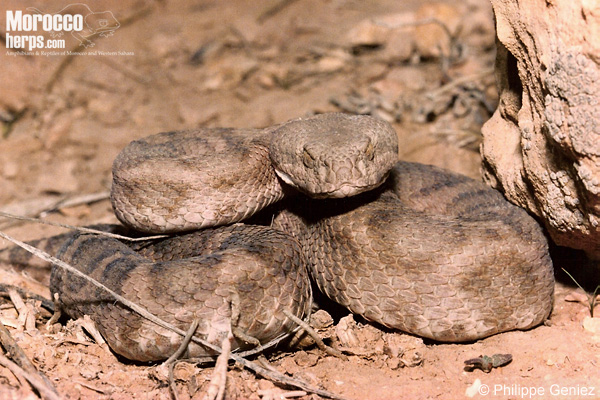
In more recent phylogenetic research with mitochondrial DNA fragments both mauritanica and deserti were grouped together with very short branches (Lenk et al., 2001; Pyron et al., 2011), suggesting a very low genetic differentiation, even below the species level (Miras et al., 2006; Stümpel & Jöger, 2011; U. Jöger, pers. comm.).
The separation of deserti and mauritanica as different species (Herrmann et al., 1987; 1992) has been criticized from the morphological point of view (Wade, 2008), because specimens of the most separated limits of the distribution of both species were used: D. mauritanica of Aouolouz, Morocco and D. deserti of Djebel Nefusa, Libya, without examining specimens of the middle of the distribution of both species (Algeria). The analysis of specimens of the “pale morph” of D. mauritanica in Algeria suggests the possibility of a clinal differentiation from northwest to southeast (Wade, 2008). In fact, apart from the colour pattern, some of the traits used in the description of deserti, such as the smooth upper head scales, are not consistent in all the currently known specimens (Schleich et al., 1996).
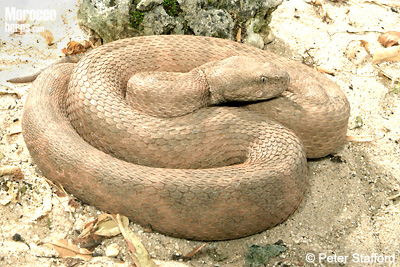
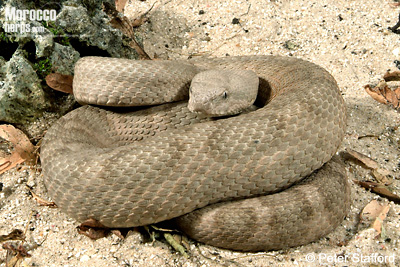
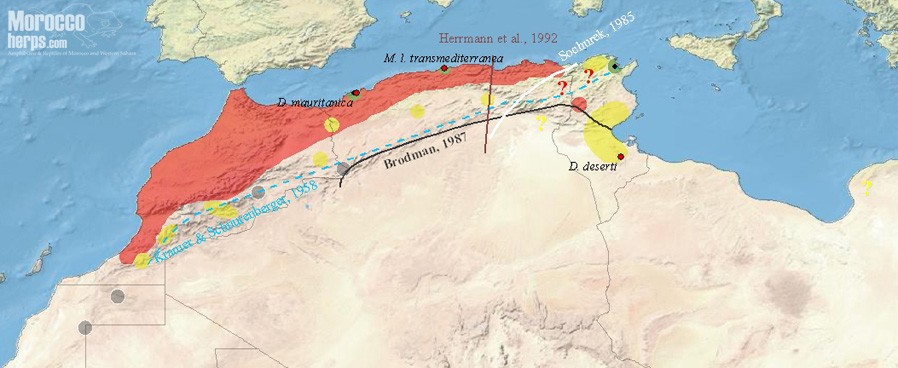
The distribution areas of both coloration patterns remain unclear. The contrasted morph of mauritanica is found in north Atlas and coastal areas of Algeria; while the pale morph of mauritanica/deserti has been observed from south of Atlas range to Lybia through the Saharan Atlas in Algeria and Tunisia. However exceptions to this range pattern have been found. The variability in the coloration of Daboia in the Maghreb is rather high.
The specimen from Djebel Murdadjo (Algeria; Nilson & Andrén, 1988) might belong to the pale morph of Daboia mauritanica/ Daboia deserti (P. Geniez, pers. comm.).
Mario Schweiger found two sympatric specimens with different colouration south of the Atlas: one contrasted (male) and one pale (female).
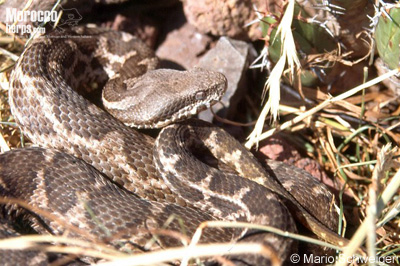
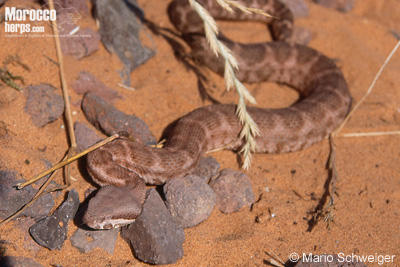
Whereas Tomas Mazuch and collaborators (pers. comm.) found two Daboia specimens with “deserti” pattern in Mediterranean habitat in northwest Tunisia, Karel Rozínek found a specimen with “mauritanica” pattern in Chambi National Park, Atlas range, where Daboia deserti should be the expected species (T. Mazuch, pers.comm.). A possibly similar pattern is found in the Chalcides ocellatus species complex, as specimens of a North Moroccoan-Algerian clade were found in Redeyef, aproximately 90 km south of Jebel Chambi (Kornilios et al., 2010).
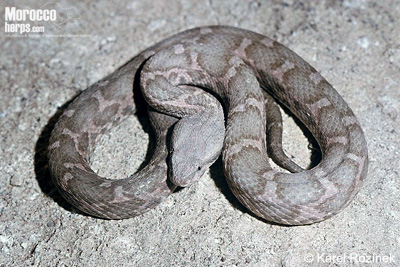
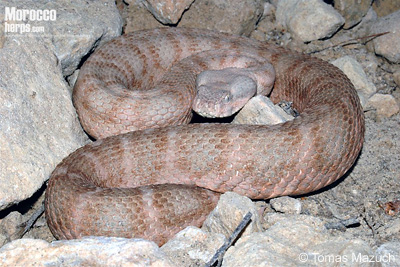
In the areas between Agadir and Tan-tan (Morocco) it is even possible to find individuals of both morphs, intermediate individuals and sometimes specimens of both “morphs” with a reddish coloration. This pattern was described for D. mauritanica (Saint-Girons, 1956, Nilson & Andrén, 1988).
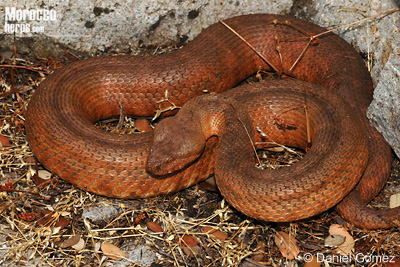
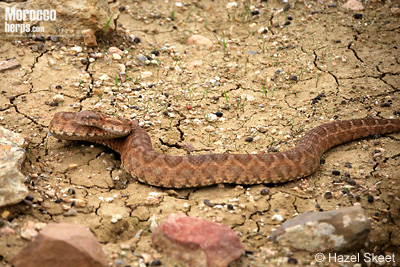
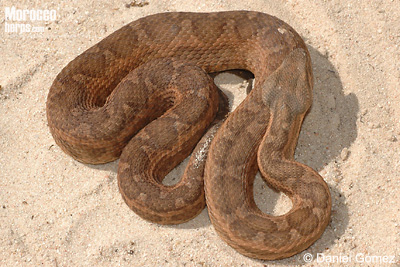
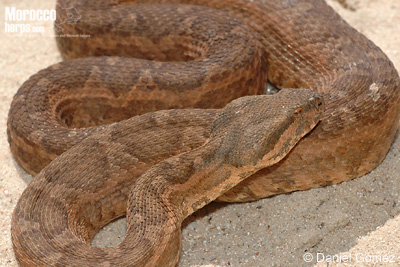
Further research with genetic phylogenies with a wide sampling all over northwest Africa, is necessary to clarify the identity of clades such us transmediterranea or deserti as full species (or subspecies). They might be simply morphological variations of D. mauritanica, or something else as a consequence of certain isolation. In a next future the population structure of this species complex will be better known.
Acknowledgements
We thank Roberto Sindaco, Ulrich Joger, Tomas Mazuch, Wolfgang Wuster, Mario Schweiger, Ed Wade, Philippe Geniez, Fernando Martínez Freiría, Juan Timms, Daniel Gómez, Hazel Skeet, Karel Rozínek, Juan Jose Calvete, Amine Bazaa, Alexander Westerström, Raúl León and Peter Stafford’s family for their pictures, articles or information.
To cite this page:
Octavio Jiménez Robles & Gabriel Martínez del Mármol Marín: Comments on the large paleartic vipers Macrovipera and Daboia in North Africa. Published on March 05, 2012. Updated on April 23, 2012. Available from http://www.moroccoherps.com/vipers-macrovipera-and-daboia-in-north-africa.
To cite www.moroccoherps.com as a whole:
Amphibians & Reptiles of Morocco and Western Sahara.
Available from www.moroccoherps.com.
Bibliography:
- Agasyan, A.; Tuniyev, T.; Cogalniceanu, D.; Wilkinson, J.; Ananjeva, N.; Orlov, N.; Böhme, W.; Lymberakis, P.; Tok, V.; Ugurtas, I.H.; Sevinç, M.; Hraoui-Bloquet, S.; Sadek, R. & Werner, Y. 2009. Macrovipera lebetina. In: IUCN 2011. IUCN Red List of Threatened Species. Version 2011.2. <www.iucnredlist.org>. Downloaded on 02 November 2011
- Anderson, J.A. 1892. On a small collection of Mammals, Reptiles, and Batrachians from Barbary. Proceedings of the Zoological Society of London. 1892: 3-24.
- Bazaa, A. ; Marrakchi1, N.; El Ayeb, M.; Sanz, L. & Calvete, J.J. 2005. Snake venomics: Comparative analysis of the venom proteomes of the Tunisian snakes Cerastes cerastes, Cerastes vipera and Macrovipera lebetina. Proteomics. 5 (16): 4223-4235
- Bazaa, A.; Juáez, P.; Marrakchi, N.; Bel Lasfer, Z.; El Ayeb, M.; Harrison, R.A.; Calvete, J.J & Sanz, L. 2006. Loss of Introns Along the Evolutionary Diversi?cation Pathway of Snake Venom Disintegrins Evidenced by Sequence Analysis of Genomic DNA from Macrovipera lebetina transmediterranea and Echis ocellatus. Journal of Molecular Evolution. 64 (2) : 261-271
- Bazaa, A. ; Luis, J. ; Srairi-Abid, N. ; Nallech-Ziri, O.; Kessentini-Zouari, R., Defilles, C. ; Lissitzky, J.C. ; El Ayeb, M. & Marrakchi, N. 2009. MVL-PLA2, a phospholipase A2 from Macrovipera lebetina transmediterranea venom, inhibits tumor cells adhesion and migration. Matrix Biology. 28 (4): 188-93
- Böhme, W. ; Lymberakis, Petros & Andrén, C. 2009. Macrovipera schweizeri. In: IUCN 2011. IUCN Red List of Threatened Species. Version 2011.2. <www.iucnredlist.org>. Downloaded on 27 December 2011.
- Bons, J. & Geniez, P. 1996. Amphibiens et reptiles du Maroc (Sahara Occidental compris). Atlas Biogéographique. Asociacion Herpetologica Espanola, Barcelone. 319 pp.
- Brodmann, P. 1987. Die Giftschlangen Europas und die Gattung Vipera in Afrika und Asien. Kümmerli und Frey. Bern. 148 pp.
- Destre, R.; Roux, P.; Geniez, P.; Tevenot, M. & Bons, J. 1989. Nouvelles observations sur l´herpétofaune marocaine. Bulletin Société Herpétologique de France. 51: 19-26
- Dobiey, M & Vogel, G. 2007. Venomous snakes of Africa. Edition Chimaira, Frankfurt. 148 pp.
- Duméril, A.M. C. & Bibron, G. 1848. In: Guichenot. Exploration Scientifique de l’Algérie: Pendant les Années 1840, 1841, 1842. Sciences Physiques. Histoire Naturelle des Reptiles et des Poissons. 5: 1-144
- Garrigues, T.; Dauga, C.; Ferquel, E.; Choumet, V. & Failloux, A.B. 2005. Molecular phylogeny of Vipera Laurenti, 1768 and the related genera Macrovipera (Reuss, 1927) and Daboia (Gray, 1842), with comments about neurotoxic Vipera aspis aspis populations . Molecular Phylogenetics and Evolution. 35 (1): 35-47
- Geniez, P.; Geniez, M.; Boissinot, S.; Beaubrun, P.C. & Bons, J. 1991. Nouvelles observations sur l´herpétofaune marocaine 2. Bulletin Société Herpétologique de France. 59: 19-27
- Geniez, P.; Mateo, J.A.; Geniez, M. & Pether, J. 2004. The amphibians and reptiles of the Western Sahara (former Spanish Sahara) and adjacent regions. Edition Chimaira, Frankfurt, 228 pp.
- Herrmann , H.W.; Joger, U.; Nilson, G. & Sibley, C.G. 1987. First steps towards a biochemically based reconstruction of the phylogeny of the genus Vipera. Proceedings of the 4th Ordinary General Meeting of the Societas Europaea Herpetologica. 195-200.
- Herrmann, H.W.; Joger, U. & Nilson, G. 1992. Phylogeny and systematics of viperine snakes III: resurrection of the genus Macrovipera (Reuss, 1927) as suggested by biochemical evidence. Amphibia-Reptilia, 13: 375-392
- Hraoui-Bloquet, S., Sadek, R. & Werner, Y. 2009. Daboia palaestinae. In: IUCN 2011. IUCN Red List of Threatened Species. Version 2011.2. <www.iucnredlist.org>. Downloaded on 27 December 2011.
- Kornilios, P.; Kyriazi, P.; Poulakakis, N.; Kumlutas, Y.; Ilgaz, C.; Mylonas, M. & Limberakis, P. 2010. Phylogeography of the ocellated skink Chalcides ocellatus (Squamata, Scincidae), with the use of mtDNA sequences: a hitch-hiker’s guide to the Mediterranean. Molecular Phylogenetics and Evolution. 54: 445-456.
- Kramer, E; & Schnurrenberger, H. 1958. Zur Schlangenfauna von Libyen. Aquarien und Terrarien Zeitschr. 11: 56-59.
- Kramer, E. & Schnurrenberger, H. 1963. Systematik, Verbreitung und Ökologie der libyschen Schlangen. Revue Suisse de Zoologie. 70: 453-568.
- Lenk, P.; Kalyabina, S; Wink, M. & Joger, U. 2001. Evolutionary relationships among the true vipers (Reptilia: Viperidae) inferred from mitochondrial DNA sequences. Molecular Phylogenics and Evolution. 19 (1): 94-104.
- Liman, I.; Bazaa, A.; Srairi-Abid, N.; Taboubi, S.; Jebali, J.; Zouari-Kessentini, R.; Kallech-Ziri, O.; Mejdoub, H.; Hammami, A.; El Ayeb, M.; Luis, J.; Marrakchi, N.2010. Leberagin-C, A disintegrin-like/cysteine-rich protein from Macrovipera lebetina transmediterranea venom, inhibits alphavbeta3 integrin-mediated cell adhesion. Matrix Biology. 29 (2): 117-26
- Miras, J.A.M., Joger, U., Pleguezuelos, J. & Slimani, T. 2006a. Daboia deserti. In: IUCN 2011. IUCN Red List of Threatened Species. Version 2011.2. <www.iucnredlist.org>. Downloaded on 27 December 2011.
- Miras, J.A.M., Joger, U., Pleguezuelos, J. & Slimani, T. 2006b. Daboia mauritanica. In: IUCN 2011. IUCN Red List of Threatened Species. Version 2011.2. <www.iucnredlist.org>. Downloaded on 27 December 2011.
- Pyron, R.A.; Burbrink, F.T.; Colli, G.R.; Nieto Montes de Oca, A.; Vitt, L.J.; Kuczynski, C.A. & Wiens, J.J. 2011. The phylogeny of advanced snakes (Colubroidea), with discovery of a new subfamily and comparison of support methods for likelihood trees. Molecular Phylogenetics and Evolution. 58: 329–342.
- Saint Girons, H. 1956. Les serpents du Maroc. Variétés Scientifiques. Socie´te´ des Sciences Naturelles et Physique du Maroc, 8: 1-29.
- Sanz, L.; Bazaa, A.; Marrakchi, N.; Pérez, A..; Chenik, M.; Bel Lasfer, Z. ; El Ayeb, M. & Calvete, J.J. 2006. Molecular cloning of disintegrins from Cerastes vipera and Macrovipera lebetina transmediterranea venom gland cDNA libraries: insight into the evolution of the snake venom integrin-inhibition system. Biochemical Journal. 395 (2): 385-92
- Schleich, H.H.; Kästle, W. & Kabisch, K. 1996. Amphibians and Reptiles of North Africa. Koeltz Science Books, Koenigstein. 630 pp.
- Sochurek, E.. 1985. Die Schlangen Tunesiens ein Überblick. Elaphe. 4: 70-72.
- Stümpel, N. & Jöger, U. 2009. Recent advances in phylogeny and taxonomy of Near and Middle Eastern Vipers – an update. Zookeys. 31: 171-191.
- Stümpel N. & Jöger, U. 2011. Phylogeny and phylogeography of Near and Middle East vipers (Daboia, Montivipera and Macrovipera). European Congress of Herpetology & Deutscher Herpetologentag.
- Venchi, A. & Sindaco, R. 2006. Annotated checklist of the reptiles of the Mediterranean countries, with keys to species identification. Part 2 -Snakes (Reptilia, Serpentes). Annali del Museo Civico di Storia Naturale “G. Doria”, Genova, XCVIII: 259-364
- Wade, E.O.Z. 2008. New reconstructive methods in scientific illustration with reference to systematic herpetology. A thesis by published work submitted for the degree of Doctor of Philosophy Middlesex University.
- Wüster, W.; Peppin, L.; Pook, C.E. & Walker, D.E. 2008. A nesting of vipers: Phylogeny and historical biogeography of the Viperidae (Squamata: Serpentes). Molecular Phylogenetics and Evolution. 49 (2): 445-459
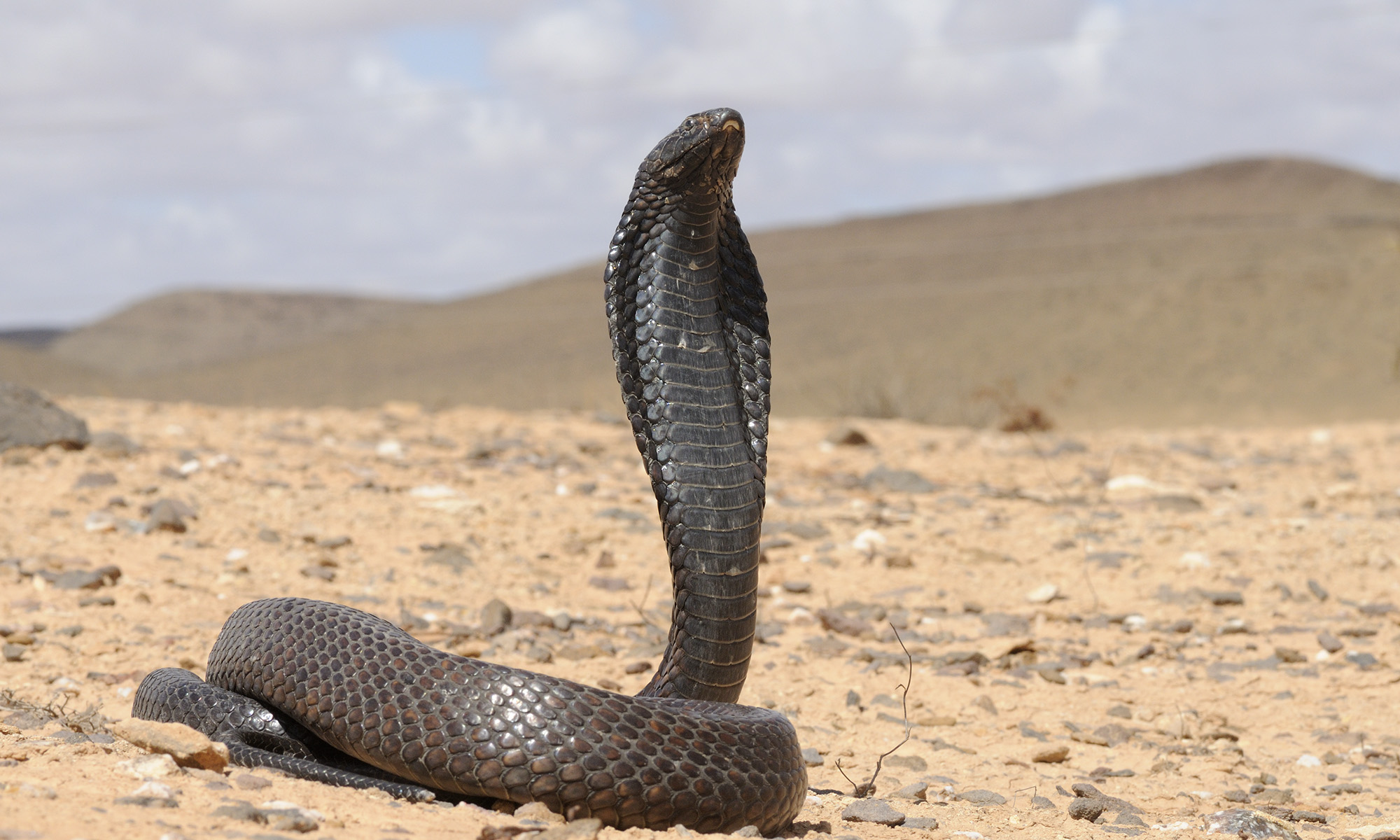

Other important point to discuss, is the question of the scarcity of Macrovipera lebetina in North Africa. Maybe D. mauritanica is a possible competitor of M. lebetina. In fact, Macrovipera lebetina has been declared extint in Israel, where Daboia palaestinae occurs both in sandy coastal areas, rocky mountain or agriculture fields. And in Jordan, Macrovipera has a patchy relictary distribution, probably due to Daboia snakes (suggested by Amr & Disi, 2011). At least in Southern Morocco, Daboia is present also in rocky areas, steppes, sandy areas, etc… so probably also the adaptable D. mauritanica could be a potential competitor for Macrovipera lebetina mediterranea and a important cause of its scarcity…
Maxhoservipera is the correct name for the genus now.
All the best
Only if you accept the validity of the genus split
Hi,
I did some field trips in Tunisia about 8 years ago I found good spots for this species in northern Tunisia.
Unfortunatly, it was during summer time and it was too hot.
We would like to plan a field trip to Algeria (near Oran) to try to find M. lebetina transmediterranea.
We would like to contact the person who made a picture of this species (JJ Calvet RT07611-4) to get more information about the location.
I personnaly contacted G. Vogel but could not get clear information about it.
Does somebody could give us more information about the picture?
It seems that Oran location is the most acurate location that why we would like to go.
In order to get some DNA samples to be compared with other close vipers to determine the indigena of this cryptic species.
Does somebody could give us more information about the spot in Algeria?
Best regards,
Didier Daminet
Maxime Pissié (abuisla.785@neuf.fr)
Hi,
Here are some pictures of two trips I made to Tunisia in August 2010 and 2011.
I join two Word documents that roughly indicate the locations (in French) of the pictures.
I prospected northern Tunisia in order to find suitable habitats for Macrovipera sp. and Daboia sp.
Unfortunatly, it was too hot I hope to go back some day in spring.
Lien du téléchargement
https://we.tl/t-RPfIIlIcS6
Any news of JJ Calvet?
Regards,
Didier